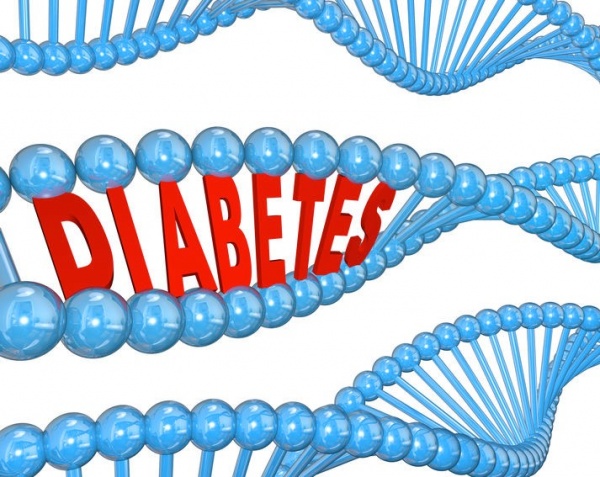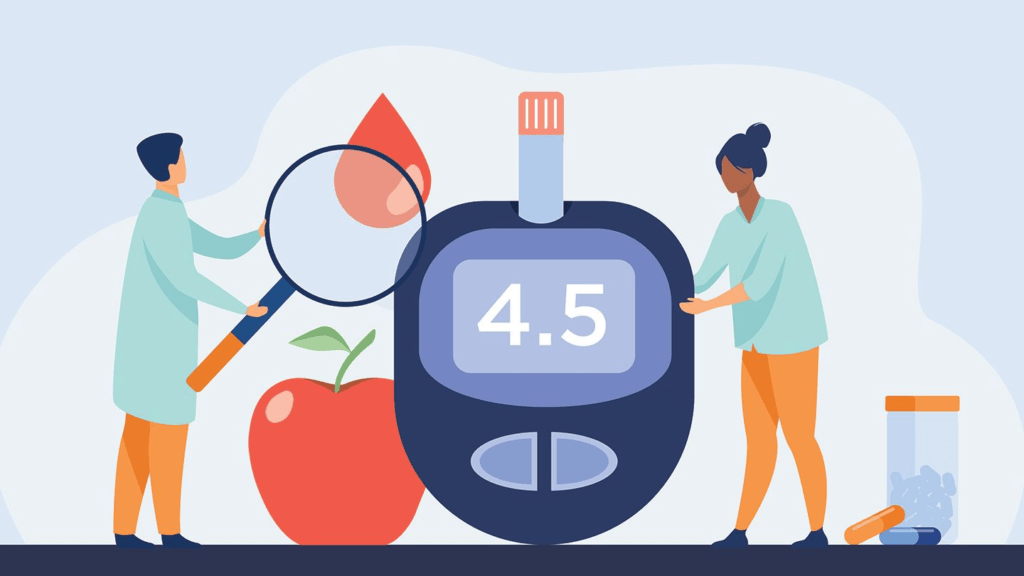Contents
Diabetes And Genes

When a person inherits diabetes from his/her parents, then we call it genetic diabetes. There is no cure for it, however, one can take some preventive measures to control diabetes.
Blood glucose is the main source of energy that we gain from the intake of the food we eat. However, high blood sugar level is the main cause of diabetes. Insulin, a hormone produced by the pancreas, stimulates glucose intake into cells so that we can use them to produce energy. Sometimes, your body doesn’t produce enough, or any insulin, or it doesn’t use it properly, which causes weakness. Glucose remains in your circulatory system and does not reach your cells as a result.
Excessive glucose intake in your blood might lead to health issues over time. This may take efforts to manage it and stay healthy. Another name for prediabetes is “a touch of sugar” or “borderline diabetes.” These words imply that someone does not have diabetes or shows a milder form of the disease. However, when we get diabetes through genes, it is not a factor of prediabetes.
Diabetes-related diseases with high blood sugar can harm your nerves, eyes, kidneys, and other organs, if left untreated. Another condition, also known as Diabetes Insipidus, is an uncommon disease that is unrelated to diabetes mellitus. This condition is different because your kidneys drain an excessive amount of fluid from your body. Hence, two main types of diabetes are type 1 and type 2 diabetes.
What Makes Diabetes Genetic?
Diabetes is a complicated disease with many different kinds and no clear cause. If a person’s family has a history of diabetes, they may be at a higher risk of acquiring the disease. Some people are more susceptible to certain forms of diabetes due to genetic factors. However, the illness will not be inherited, and there are treatments to lower the risk. Knowing how type 2 diabetes impacts family members helps people to take preventive measures.
Genetic Mutations are one of the main causes of inheritance of Diabetes to the younger generations. A gene mutation is a condition when a child exhibits variations in the sequence of DNA passed on to him by his parents.
A single gene mutation (monogenic variation), numerous gene mutations (multifactorial inheritance variation), a combination of gene mutations and environmental factors, or chromosome damage can all cause genetic illnesses. It also appears in varied numbers or structures of entire chromosomes.
Monogenic Diabetes
Monogenic diabetes is a rare kind of diabetes caused by mutations (changes) in just one gene. On the other hand, type 1 diabetes and type 2 diabetes are caused by a combination of genes. Though some other causes of type 2 diabetes can include lifestyle factors such as obesity. The majority of cases of monogenic diabetes are hereditary.
Monogenic diabetes presents itself in a variety of ways and affects mainly young people aged 25 or below. Insulin is manufactured to help the body utilize glucose (sugar) for the production of energy. It is harmful in most forms of diabetic conditions directly or indirectly.
Severe insulin resistance, a condition in which the body is unable to utilize insulin appropriately is a rare occurrence. A precise diagnosis can assist people in receiving the appropriate treatment. However,
- Some children with monogenic diabetes are prescribed insulin. It is so because the doctors misdiagnose them with having type 1 diabetes.
- When diagnosed appropriately, some of these youngsters may be able to take diabetes medications instead, resulting in even better glucose control.
- A precise diagnosis may also benefit family members who may be suffering from monogenic diabetes and are unaware of it.
Cystic Fibrosis
Type 1 and Type 2 diabetes share some characteristics with Cystic Fibrosis-Related Diabetes (CFRD). The thick, viscous mucus that is a characteristic of Cystic Fibrosis promotes scarring of the pancreas in patients.
Because the scarring stops the pancreas from producing normal amounts of insulin, there is a severe deficiency of insulin in the body, just like those with type 1 diabetes. Their pancreas still produces some insulin, but not enough to keep them healthy and nutritious.
Hyperglycemia, or high blood sugar, causes certain typical symptoms such as increased thirst and urination. Excessive fatigue, weight loss, and an unexplained decrease in lung function are also indications of CFRD.
The goal of CFRD treatment is to maintain/balance:
- normal blood sugar levels,
- weight by maintaining muscle mass, and feel better with more energy,
- normal glucose levels, that reduces the risk of diabetes-related complications.
Hemochromatosis
Hemochromatosis is a condition in which your body absorbs more iron from your food than it requires. The pancreas is the place where iron stores.
It then affects the pancreas, preventing it from producing enough insulin, which requires glucose (sugar) to enter our cells. Because there is not enough insulin, people with untreated diabetes have excessive glucose in their blood and iron in the pancreas.
As a result, an increase in iron in your blood can harm your pancreas. This indicates that it is unable to produce insulin effectively. Hemochromatosis causes secondary diabetes in this manner.
The best method to avoid diabetes is to get treatment for hemochromatosis. Your pancreas is less likely to be damaged if you optimize your iron intake. Hemochromatosis can have a variety of ways of treatments as:
- Phlebotomy, which is drawing blood to optimize iron levels.
- Chelation therapy, when you take medication to lower your body’s iron levels.
- Dietary recommendations, it is recommended sometimes as part of a therapy strategy. You can avoid some supplements such as vitamin C and iron as a result of these alterations. Also, don’t overindulge in alcoholic beverages.
Factors Responsible for Genetic Diabetes
We can observe genetic diabetes in a child quite early, whereas, in the general population, it develops after a specific age.
Diabetes can also be passed down through the generations from either mother or father, based on the dominance of genes. In case of inheriting it from father, the child’s risk of developing diabetes is higher in the age group of 1 to 10 years, whereas, in case of taking it from mother, it may develop in the age group between the or 1 to 4, respectively, if both the father and mother have diabetes before the age of 11 years.
Genetic Factors Affecting Type 1 Diabetes
Type 1 diabetes is an autoimmune illness. It occurs when the body’s immune system kills healthy cells by mistake. This type most commonly appears during puberty, however, it can develop at any age. Doctors used to believe that type 1 diabetes was entirely hereditary. Not everyone with type 1 diabetes, however, has a family history of the disease.
Scientists have discovered alterations in the genes that create particular proteins in people with type 1 diabetes. These proteins are essential for the immune system to function properly. These genetic characteristics make a person prone to acquire type 1 diabetes, which can trigger a variety of circumstances. When a doctor diagnoses someone with type 1 diabetes, they will have it for the rest of their lives.
Some of the symptoms that develop or shows diabetes are:
- Increased thirst
- Frequent urination
- Bed-wetting in children
- Extreme hunger
- Unintended weight loss
- Irritability and other mood changes
- Fatigue and weakness
- Blurred vision
More On Inheriting Type 1 Diabetes Through Genes
Autoimmune antibodies can be found in the blood of people with type 1 diabetes for years before symptoms appear.
It’s possible that the problem could worsen over time, or something would have to trigger the autoimmune antibodies before symptoms arise. Symptoms usually occur shortly after this triggering, within days or weeks. Moreover, some of the causes that may complicate type 1 diabetes are:
- Family history: Type 1 diabetes is caused by hereditary vulnerability to the disease. You are at a higher risk if a family member has (or had) the disease. If both parents have (or had) type 1 diabetes, their child is more likely to develop it than if just one parent has (or had) diabetes. Researchers have discovered that if the father has type 1 diabetes, the chances of a child having it are somewhat higher than if the mother or a sibling has type 1.
- Early diet: Researchers believe that children who were given cow’s milk at an early age have a slightly higher risk of developing type 1 diabetes.
- Viruses: Many researchers think that some viruses can also activate type 1 diabetes with genetic factors. Some of these viruses are measles, Coxsackie B, mumps, and rotavirus.
Genetic Factors Affecting Type 2 Diabetes
Type 2 diabetes is the most frequent kind, accounting for 90–95 percent of all diabetes cases that take place due to genes. People with type 2 diabetes, like those with type 1, probably have a close diabetic family member.
If you have type 2 diabetes, you’re probably not the first person in your family to develop the disease. If a parent or sibling has the disease, you’re more likely to have it. The development of type 2 diabetes is linked with several genetic factors. These gene variants can interact with each other and the environment to raise your risk.
In general, mutations in any gene involved in glucose regulation can raise your risk of developing type 2 diabetes. These genes include the regulation of;
- the process of glucose production
- the production and control of insulin, and
- how the body detects glucose levels.
Type 2 includes some symptoms that develop or show diabetes genetics as:

- Urination (Polyuria),
- Excessive Thirst (Polydipsia),
- Fatigue,
- Blurred Vision,
- Numbness in the hands and feet (Diabetic Neuropathy),
- Sores that do not heal well, and
- Weight Loss
More On Inheriting Type 2 Diabetes Through Genes
Type 2 diabetes has a greater link to family history and lineage than type 1, and twin studies have revealed that genes significantly influence the development of type 2 diabetes. The race might also be a factor.
If you have a family history of type 2 diabetes, then determining whether your diabetes is caused by lifestyle factors or genetics might be difficult. However, it is a combination of the two. Exercising and losing weight have been shown in researches to help delay or prevent type 2 diabetes. However, some of the causes that may complicate type 2 diabetes are:
- Prediabetes
- Multiple gene mutations associated with type 2 diabetes,
- A family history of diabetes,
- Diagnosed with high blood pressure,
- Age 45 years older,
- Are overweight, or
- Less active more than 3 times a week
Is Genetic Testing Useful For Diabetes?
Diabetes is a chronic disease that characterizes high blood glucose levels, and an inability to adequately metabolize meals for energy. It is a diverse illness with numerous forms and a genetic etiology that is usually complex.
Moreover, an estimate of about 80% of people is MODY (Maturing Onset Diabetes of the Young). The doctors misdiagnose them as having Type 1 or Type 2 diabetes. This implies that genetic testing in diabetes with such cases is as important as it can benefit in preventing diabetes.
In type 1 and type 2 diabetes, genetics also plays a part, but the etiology is polygenic, with mutations in dozens of genes, each with a modest effect, adding up to increase a person’s risk of inheriting of disease. Because there is no specific gene that causes type 1 diabetes, testing has proved problematic.
Furthermore, some new tests that integrate the multiple gene variants play a role in type 1 diabetes. It can predict up to 90% of cases that are developing. One of them includes a saliva sample used as a test, which is then compared with 82 genetic sites.
However, in the prediction of type 2 diabetes, models are improving with an increase in the precision of the diagnosis of the disease. However, diagnosis of type 2 diabetes can improve in the following ways:
- Identifying low-frequency and rare genetic variants,
- Identifying risk variants for type 2 diabetes,
- Increasing knowledge of structural variation and epigenetics, and
- Developing statistical techniques to evaluate gene-to-gene and gene-environment interactions
Gene Therapy For Diabetes
Gene therapy using viral vectors and non-viral transduction are effective in treating type 1 diabetes. Hence, this therapy can be used in various ways, including suppressing autoreactive T cells to avoid islet destruction (prophylactic) or replacing the insulin gene (post-disease). For an extended period of time, typically four months, the gene therapy strategy restores normal blood glucose levels.
A Word From MantraCare
Do you want to get rid of diabetes? Join our online diabetes consultation program and reverse your Diabetes naturally through lifestyle changes such as a Personalized Diet plan, Exercise, dieticians, and health coaches.


